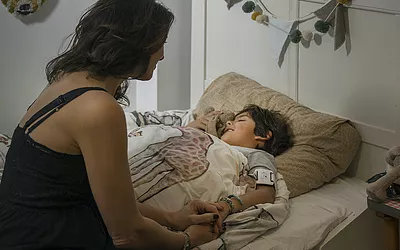Children with epilepsy
In the UK, around 1 in every 200 children and young people under 18 are diagnosed with epilepsy (epilepsy society).
The total number of children aged 4 years and under with epilepsy is approximately 1 in 509 and besides the 1 in 200 of children and young people under 18, the number of young people who are 25 years and under with epilepsy is around 112,000 (Young Epilepsy).
There are various types of epilepsy: Most types only occur during childhood (4-12 years of age) and go away as the child grows up. Most children respond well to anti-epileptic drugs (AEDs) to control the seizures. Around one-third of the children nevertheless continue to have seizures. One of the reasons for this is that some types of epilepsy are so very complex that AEDs are insufficiently effective. Furthermore, AEDs can sometimes cause side effects in children, as a result of which alternative treatments may be considered. Some children also have seizures at night, which can sometimes go unnoticed. This is a cause of stress for many parents and carers.

Parents are therefore urged to think carefully about the safety aspect and decisions as to what your child may and may not do. It will likely change your everyday life. So what causes epilepsy in children? What are the symptoms? When can a diagnosis be made? What are the consequences for you and your child? What are the treatment options? And how can you create a sense of security and confidence?
Symptoms in children with epilepsy
An epileptic seizure is caused by a temporary, often abrupt interruption of electrical signals between brain cells. Epilepsy can be difficult to diagnose in children. A single seizure need not mean that your child has epilepsy. A low blood sugar level, headache, fever or an acute illness can also cause seizures. These are not directly related to epilepsy. Epilepsy can only be diagnosed by a specialist.
There are various types of epilepsy with different types of seizures. If your child has had a seizure it is important that you follow a doctor’s instructions. First of all, you should wait until the seizure has passed. In the meantime, stay with your child and reassure them by talking calmly. Last but by no means least, ensure they are safe. Make sure your child cannot hurt themselves during a seizure.
Epileptic seizures can be relatively unnoticeable, such as absence seizures, when they will briefly be totally unresponsive. Other symptoms include twitching of the corners of the mouth or brief difficulty speaking, as with Benign rolandic epilepsy. The best-known type of seizure is when a person loses consciousness and their whole body makes jerking movements (convulsions). An epileptic seizure usually stops by itself after a while but in some cases, an intervention of some kind may be needed to stop the seizure.
Causes of epilepsy in children
There are various causes of epilepsy in children. Children who had a difficult birth or were born prematurely have a greater risk of developing epilepsy. A lack of oxygen during birth, infections and viruses also increase the risk of epilepsy. In some cases, epilepsy has a genetic cause.
Around 50-70% of the children eventually grow out of their seizures. This is most likely to happen in children who respond well to medication, have relatively few seizures or when there is no evidence of an underlying neurological problem.
Treatment for children with epilepsy
Anti-epileptic drug treatment is successful in the majority (80%) of children with epilepsy.
This AED medication makes the brain cells less sensitive to stimuli and can control (stop) or reduce the seizures. Which type of medication is suitable for your child will depend on the cause and type of their epilepsy. Do look out for side effects. Some drugs can affect children’s behaviour or make them less alert, for example. Always discuss any side effects with your attending physician.
In some cases, if, for example, the seizures do not stop, the medication has many side effects, or your child’s development is not progressing as expected, he/she may be referred to an epilepsy centre or university hospital. An operation may sometimes be an option but is not without risk.

Social consequences for parents/carers and children with epilepsy
Epileptic seizures can affect the lives of both you and your child in various ways. Much will change and it will take a while for your child to get used to that.
They will need to go to the hospital more often and often have to take medication. Epilepsy affects the cognitive development of approx. 20% of the children, in some cases leading to concentration or memory problems. Behavioural and psychiatric problems, such as ADHD and autism, are also more common in children with epilepsy.
For many parents, witnessing their child’s first epileptic seizure is an upsetting experience. It can give rise to stress and concern and often to disturbed nights. Unsure of what to do in the event of another seizure or worried they might not notice another seizure, many parents choose to sleep in their child’s room rather than in their own bed. As a parent, it is important that you are well informed. Discuss it with your doctor, neurologist or epilepsy nurse. They can provide you with both information and support.
More information
More information about epilepsy in children can be found on the website of epilepsy society.
Risks for children with epilepsy
Generally speaking, epilepsy in children is not a life-threatening condition. There are exceptions, however, when your child could be at risk during a seizure. If they fall during a seizure or feel no pain, for example, and consequently hurt themselves. Another risk is SUDEP when a person unexpectedly dies during their sleep after an epileptic seizure. Read more about this under “Nocturnal epilepsy”
Nocturnal epilepsy
If children have nocturnal (night-time) seizures, they will often make strange movements or adopt a strange position. This will often include movements of the shoulders, pelvis, arms or legs. Children may also have convulsions during a nocturnal seizure. Most nocturnal seizures are brief and mainly occur at the beginning of the night or just before waking. Lack of sleep, stress, and certain sounds can trigger nocturnal seizures in some children. Nocturnal epileptic seizures are difficult to recognise in children. This can lead to unsafe or high-risk situations.
A SUDEP is a Sudden Unexpected Death in Epilepsy. As the name suggests, the exact causes of SUDEP are not known. It happens most commonly in people who have severe nocturnal seizures, such as tonic-clonic seizures. However, SUDEP is also linked to tonic seizures, hypermotor seizures, and clusters of myoclonic seizures. SUDEP affects around 1 in 1,000 people with epilepsy each year and is less common in children than in adults. We know that the risk of a SUDEP is smaller if someone else is in the same room during or immediately following the seizure.
Generally speaking: the fewer the seizures, the lower the risk. So it is important to prevent or limit the seizures as much as possible. Many parents of children with epilepsy are afraid to leave their child alone at night so opt to sleep in their child’s bedroom.
An early warning system can help in the event of nocturnal seizures. A detection and alarm device detects a seizure and transmits an alarm, ensuring that seizures are noticed, unsafe situations are avoided, and adequate aid can be provided quickly. There are various seizure monitoring systems. However, many of these systems fail to detect seizures or often give false alarms. There is great demand among parents for a reliable seizure detection system that allows for more restful nights.